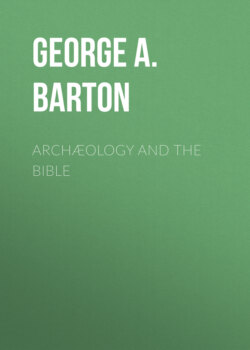Читать книгу Archæology and the Bible - George A. Barton - Страница 10
На сайте Литреса книга снята с продажи.
ОглавлениеThe site of this temple was at Tell el-Yehudiyeh, the “Tell of the Jewess,” about 20 miles north of Cairo. This tell was excavated by Petrie in 1905-1906. He found there remains of the Jewish temple, which fully confirm the statements of Josephus. Not only the temple, but the form of the Jewish settlement, was made as far as possible a replica of the city of Jerusalem. One of the most interesting discoveries was a series of ovens for the roasting of Paschal lambs. Others of a similar character were found higher up in the mound, but this first series was most numerous. Petrie infers that the temple was dedicated by a great Passover Feast, to which Jews came in large numbers from throughout Egypt;[8] (see Fig. 13).
(10) Papyri from Oxyrhynchus.—About 123 miles south of Cairo and nine miles to the west of the Nile lies the town of Behnesa, which the Greeks called Oxyrhynchus, from a sharp-nosed fish which was sacred there. Since 1897 Grenfell and Hunt, two English explorers, have been season after season exploring the rubbish heaps of the old town. The inhabitants committed the contents of their waste-baskets to the sands, and on account of the dry climate these have never decayed. Here were found the “Sayings of Jesus,” some of the documents concerning the Roman census, and some of the letters translated in Part II, pp. 432, ff., 440, ff., as well as many remains of the works of classical authors. Similar documents have been found in other parts of Egypt, but no other site has yielded as many as Oxyrhynchus.
(11) Discoveries in Nubia.—During the winter of 1908-1909 MacIver explored at Karanog in Nubia for the University of Pennsylvania. He found in a cemetery many remains of the civilization of the Christian Nubians. They still called their queen Candace (see Acts 8:27), fed her on milk, and regarded obesity as an attribute of royalty. More will be known of the Nubians of this period when the inscriptions discovered at Karanog and at Shablul, deciphered by Mr. Griffith, have been more completely studied. The explorations of the English at Meroe have afforded a connected view of the development of this Nubian civilization. They found there the remains of an early period extending from about 650-400 B. C., which was followed by about a century when the royal residence was elsewhere, a middle period from 300 to 1 B. C., during the latter part of which Hellenic influences were felt, and a late period, from 1 to 350 A. D., during which Roman forms of art penetrated the country.[9]
